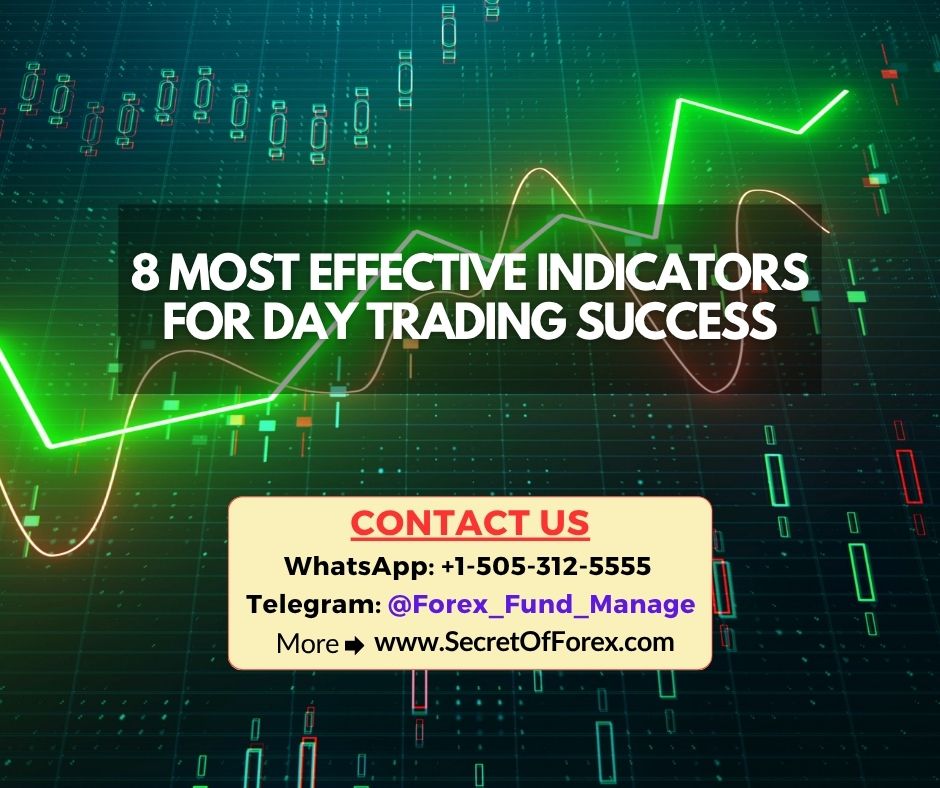Blog
8 Most Effective Indicators for Day Trading Success
Day trading is a fast-paced, high-risk trading method in which financial products are bought and sold on the same trading day. To win, day traders must make rapid judgments based on sound technical analysis. This is where indications come in. Technical indicators give information on price movement, trends, momentum, and market volatility, all of which are necessary for making timely and effective trades. In this post, we’ll look at the 8 most effective indicators for increasing your chances of success in day trading. 8 Most Effective Indicators for Day Trading Success
Download Now Non-Repaint Indicator
Telegram Channel Visit Now
Fund Management Services Visit Now
1. Moving Averages (MA) – Identifying Trends Quickly : 8 Most Effective Indicators for Day Trading Success
Why It’s Useful: Moving Averages smooth out price volatility and indicate trend direction, allowing traders to make better judgments amid tumultuous market circumstances.
Types:
- Simple Moving Average (SMA): Calculates the average closing price for a certain time.
- Exponential Moving Average (EMA): Provides greater weight to current prices, making it ideal for day trading.
Best Practices:
Use shorter EMAs, such as 9 or 20 periods, to get quicker signals. A crossover between two EMAs (for example, 9 EMA crossing over 21 EMA) is often used to signal entry or exit.
2. Relative Strength Index (RSI) – Identifying Reversal Zones
Why it is useful:
The RSI indicator evaluates the intensity and speed of price changes. It’s an oscillator that may detect overbought or oversold levels, which are often accompanied by price reversals.
How This Works:
- The RSI spans from 0 to 100.
- Above 70 = overbought (suggest selling) * Below 30 = oversold (suggest buying)
Best Practices:
Look for RSI divergences, which occur when the price establishes a new high or low but the RSI does not, indicating probable reversal.
3. Moving Average Convergence Divergence (MACD) Momentum Confirmation
Why it is useful:
MACD is a trend-following and momentum indicator. It aids in determining the direction and intensity of a trend, which is critical in high-frequency trading.
How This Works:
The indicator includes a MACD line, signal line, and histogram. A MACD crossing above the signal line indicates a bullish trend.
- A crossing below the signal line is bearish.
Best Practice: Combine MACD with price action and volume for further confirmation before placing a trade.
4. Bollinger Bands: Detecting Volatility and Breakouts
Why it is useful:
Bollinger Bands are used to assess market volatility. They grow as volatility rises and compress when it falls, indicating possible breakouts or reversals.
How This Works:
- Middle band: 20-period SMA.
- Upper/lower bands are 2 standard deviations from the SMA.
Best Practice: Look for “Bollinger Band Squeeze” (narrow bands), which generally precedes a breakthrough. Combine with momentum indicators to validate the direction.
5. Volume: Confirming Trade Signals – 8 Most Effective Indicators for Day Trading Success
Why It’s Useful: Volume indicates the amount of interest in price change. It demonstrates the power of breakouts and reversals.
How This Works:
- High volume during a breakthrough demonstrates its strength. Low volume might signal a false breakout or a weak trend.
Best Practices:
Validate trade setups by combining volume spikes with candlestick patterns or support/resistance zones.
6. Stochastic Oscillator – Detecting Short-Term Reversals
Why it is useful:
The stochastic oscillator is a useful tool for identifying overbought or oversold circumstances in a range market.
How This Works:
- Scale: 0 to 100 * Above 80 = overbought * Below 20 = oversold.
Best Practices:
Look for %K and %D crossings in overbought/oversold territory. Combine with support/resistance or trendlines to improve your entry strategy.
7. Average True Range (ATR): Measuring Market Volatility
Why it is useful:
ATR enables traders to evaluate how much an asset generally moves, which is critical for establishing realistic stop-loss and take-profit levels.
How This Works:
It computes the average of true ranges for a specified time period (typically 14). Higher ATR values imply more volatility.
Best Practice: Set dynamic stop-loss levels (e.g., 1.5x ATR) based on current market circumstances.
8. VWAP (Volume Weighted Average Price): Institutional Benchmark – 8 Most Effective Indicators for Day Trading Success
Why it is useful:
VWAP is the average price of a securities based on volume and pricing. It is often used by institutional traders to assess transaction quality.
How This Works:
Prices above VWAP indicate a bullish bias, while prices below VWAP indicate a bearish inclination.
Best Practice: Use VWAP for dynamic support/resistance levels. Look for long chances when the price returns to VWAP in an uptrend, and vice versa.
Download Now Non-Repaint Indicator
Telegram Channel Visit Now
Fund Management Services Visit Now
Conclusion
Day trading necessitates split-second decisions, and technical indicators serve as your guidance through fast-moving markets. The eight indicators mentioned are Moving Averages, RSI, MACD, Bollinger Bands, Volume, Stochastic Oscillator, ATR, and VWAP, and each provides distinct insights into market situations. While no one indication assures success, combining 2-3 complimentary signs with effective risk management may significantly increase your accuracy and consistency.
Before going live, always test your approach on a demo account. Keep in mind that indicators are tools, not magic bullets. Their ultimate value comes in how effectively they are interpreted in the context of price movement and market activity.
Read also this
8 Most Effective Indicators for Day Trading Success
The Ultimate Guide to the Best MT4 Indicators for Gold Trading
Top 5 MT4 Indicators for Gold Trading You Should Try
What Is Free Automatic Buy Sell Forex Signal Software
What Are the Best Technical Indicators for Day Trading
How Does Forex Signal Software Work
Why Use High Probability Scalping Strategies for Trading
Step-by-Step Guide to Implementing the Super Reversal Signal Indicator

